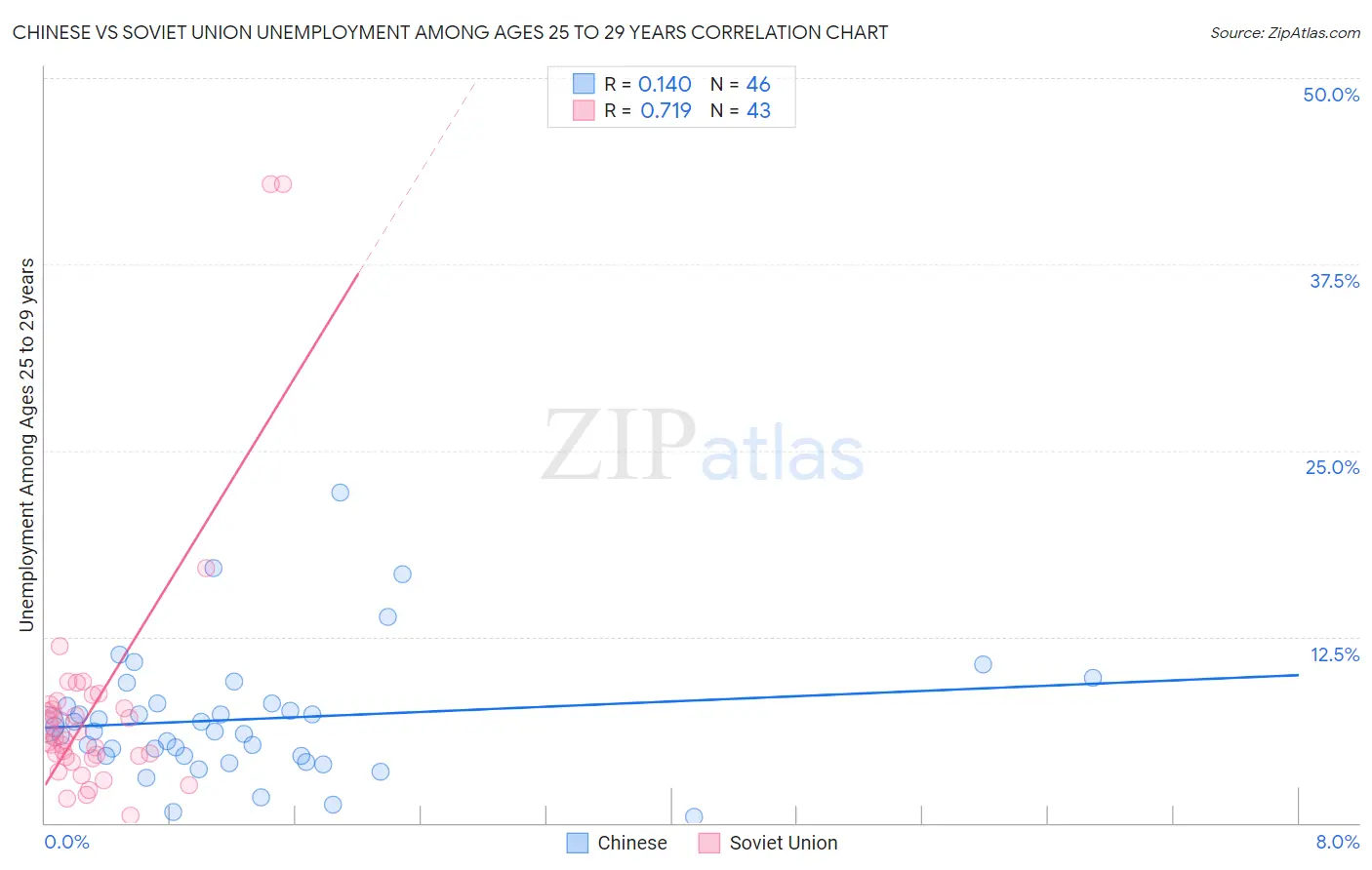Chinese vs Soviet Union Unemployment Among Ages 25 to 29 years
COMPARE
Chinese
Soviet Union
Unemployment Among Ages 25 to 29 years
Unemployment Among Ages 25 to 29 years Comparison
Chinese
Soviet Union
6.1%
UNEMPLOYMENT AMONG AGES 25 TO 29 YEARS
99.6/ 100
METRIC RATING
32nd/ 347
METRIC RANK
6.2%
UNEMPLOYMENT AMONG AGES 25 TO 29 YEARS
98.9/ 100
METRIC RATING
50th/ 347
METRIC RANK
Chinese vs Soviet Union Unemployment Among Ages 25 to 29 years Correlation Chart
The statistical analysis conducted on geographies consisting of 63,787,303 people shows a poor positive correlation between the proportion of Chinese and unemployment rate among population between the ages 25 and 29 in the United States with a correlation coefficient (R) of 0.140 and weighted average of 6.1%. Similarly, the statistical analysis conducted on geographies consisting of 43,269,095 people shows a strong positive correlation between the proportion of Soviet Union and unemployment rate among population between the ages 25 and 29 in the United States with a correlation coefficient (R) of 0.719 and weighted average of 6.2%, a difference of 1.6%.

Unemployment Among Ages 25 to 29 years Correlation Summary
| Measurement | Chinese | Soviet Union |
| Minimum | 0.40% | 0.50% |
| Maximum | 22.2% | 42.9% |
| Range | 21.8% | 42.4% |
| Mean | 7.0% | 7.7% |
| Median | 6.3% | 5.8% |
| Interquartile 25% (IQ1) | 4.5% | 4.4% |
| Interquartile 75% (IQ3) | 8.0% | 8.0% |
| Interquartile Range (IQR) | 3.5% | 3.6% |
| Standard Deviation (Sample) | 4.2% | 8.4% |
| Standard Deviation (Population) | 4.2% | 8.3% |
Demographics Similar to Chinese and Soviet Union by Unemployment Among Ages 25 to 29 years
In terms of unemployment among ages 25 to 29 years, the demographic groups most similar to Chinese are Yugoslavian (6.1%, a difference of 0.10%), Filipino (6.1%, a difference of 0.35%), Immigrants from Morocco (6.1%, a difference of 0.36%), Immigrants from Zimbabwe (6.1%, a difference of 0.40%), and Taiwanese (6.1%, a difference of 0.42%). Similarly, the demographic groups most similar to Soviet Union are Burmese (6.2%, a difference of 0.030%), German Russian (6.2%, a difference of 0.060%), Immigrants from Australia (6.2%, a difference of 0.12%), Latvian (6.2%, a difference of 0.14%), and Immigrants from Lithuania (6.2%, a difference of 0.16%).
| Demographics | Rating | Rank | Unemployment Among Ages 25 to 29 years |
| Filipinos | 99.7 /100 | #31 | Exceptional 6.1% |
| Chinese | 99.6 /100 | #32 | Exceptional 6.1% |
| Yugoslavians | 99.6 /100 | #33 | Exceptional 6.1% |
| Immigrants | Morocco | 99.5 /100 | #34 | Exceptional 6.1% |
| Immigrants | Zimbabwe | 99.5 /100 | #35 | Exceptional 6.1% |
| Taiwanese | 99.5 /100 | #36 | Exceptional 6.1% |
| Immigrants | Serbia | 99.5 /100 | #37 | Exceptional 6.1% |
| Ethiopians | 99.4 /100 | #38 | Exceptional 6.1% |
| Indonesians | 99.3 /100 | #39 | Exceptional 6.1% |
| Immigrants | Kenya | 99.3 /100 | #40 | Exceptional 6.1% |
| Fijians | 99.3 /100 | #41 | Exceptional 6.1% |
| Jordanians | 99.3 /100 | #42 | Exceptional 6.1% |
| Czechs | 99.2 /100 | #43 | Exceptional 6.2% |
| Mongolians | 99.2 /100 | #44 | Exceptional 6.2% |
| Venezuelans | 99.1 /100 | #45 | Exceptional 6.2% |
| Immigrants | Lithuania | 99.0 /100 | #46 | Exceptional 6.2% |
| Latvians | 99.0 /100 | #47 | Exceptional 6.2% |
| Immigrants | Australia | 99.0 /100 | #48 | Exceptional 6.2% |
| German Russians | 99.0 /100 | #49 | Exceptional 6.2% |
| Soviet Union | 98.9 /100 | #50 | Exceptional 6.2% |
| Burmese | 98.9 /100 | #51 | Exceptional 6.2% |